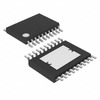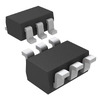Manufacturer Part Number
MAX913CPA
Manufacturer
analog-devices
Introduction
The MAX913CPA is a high-speed, precision linear comparator designed for use in systems requiring fast response times and low power consumption.
Product Features and Performance
Single element comparator with latch feature
Complementary TTL output
Operating voltage range between 5V and 10V
Low input offset voltage: max 2mV at ±5V
Low input bias current: max 5µA at ±5V
Output current typically 20mA
Quiescent current maximum 10mA
High common mode rejection ratio (CMRR): 110dB
High power supply rejection ratio (PSRR): 100dB
Propagation delay maximum 14ns
Product Advantages
Fast response times suitable for high-speed applications
Low power consumption enhances system efficiency
High precision with low input offset voltage and bias current
Robust noise rejection through high CMRR and PSRR values
Key Technical Parameters
Type: with Latch
Output Type: Complementary, TTL
Voltage Supply, Single/Dual (±): 5V ~ 10V
Voltage Input Offset (Max): 2mV @ ±5V
Current Input Bias (Max): 5µA @ ±5V
Current Output (Typ): 20mA
Current Quiescent (Max): 10mA
CMRR, PSRR (Typ): 110dB, 100dB
Propagation Delay (Max): 14ns
Operating Temperature: 0°C ~ 70°C
Quality and Safety Features
High reliability in various temperature conditions from 0°C to 70°C
Compatibility
Compatible with TTL output requirements
Flexible with a supply voltage range of 5V to 10V
Application Areas
High-speed signal processing
Data acquisition systems
Communication systems
Pulse and waveform generation
Industrial control systems
Product Lifecycle
Obsolete status, indicating that it is nearing discontinuation
Users should consider preparing for replacements or upgrades
Several Key Reasons to Choose This Product
Exceptional speed with a propagation delay of maximum 14ns making it ideal for fast systems
Low power requirement enhances system efficiency and longevity
High-level precision due to low input offset voltage and bias current
Excellent for systems where noise rejection is critical, with high CMRR and PSRR
Obsolete status may drive the exploration of newer, more advanced replacements




 MAX9130EXT TAnalog Devices / Maxim Integrated
MAX9130EXT TAnalog Devices / Maxim Integrated MAX9132GUP+TAnalog Devices Inc./Maxim IntegratedIC VID LVDS CROSSBAR SW 20TSSOP
MAX9132GUP+TAnalog Devices Inc./Maxim IntegratedIC VID LVDS CROSSBAR SW 20TSSOP MAX912CSEAnalog Devices Inc./Maxim IntegratedIC COMPARATOR 2 W/LATCH 16SOIC
MAX912CSEAnalog Devices Inc./Maxim IntegratedIC COMPARATOR 2 W/LATCH 16SOIC MAX912ESE+
MAX912ESE+ MAX9130EXT+TAnalog Devices Inc./Maxim IntegratedIC RECEIVER 0/1 SC70-6
MAX9130EXT+TAnalog Devices Inc./Maxim IntegratedIC RECEIVER 0/1 SC70-6